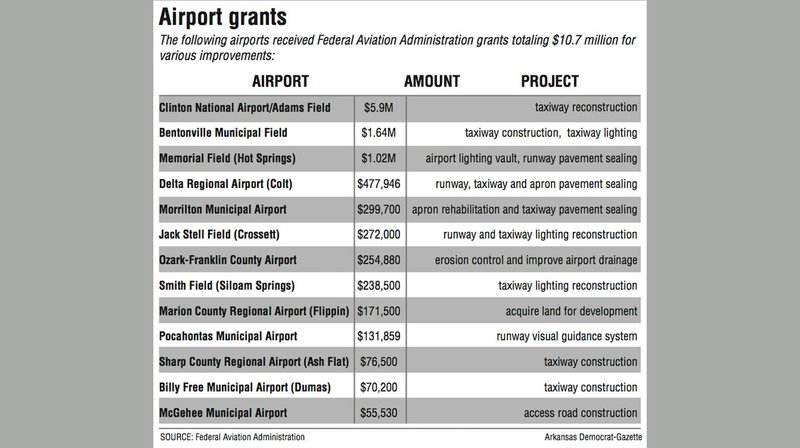A baker's dozen of the state's airports, large and small, have been awarded Federal Aviation Administration grants totaling $10.7 million to pay for safety and infrastructure improvements.
More than half of the latest round of funding for 13 Arkansas airports in the Airport Improvement Program went to Bill and Hillary Clinton National Airport/Adams Field, which is the state's largest -- and busiest -- airport. At last count, the state had 93 airports, most of them small.
Clinton National is set to receive a total of $5.9 million spread over two years to help pay for improvements to a section of the taxiway running in front of the complex that is home to Dassault Falcon, the airport's biggest tenant. The company completes its business jets at the facility, outfitting them with trim, paint, interior features and avionics to customer specifications.
The section is the last on the taxiway to have an asphalt surface. The new surface will be concrete. The project is part of a multiyear effort to strengthen the airport's surface system to handle the heavier weights of the bigger business jets that are increasingly common at Clinton National.
The grants pay for more modest improvements at other airports.
The grant program "allows the smaller airports to do projects that they otherwise would not be able to do," said Jerry Chism, director of the aeronautics division of the Arkansas Department of Commerce. "The money coming in from the FAA is absolutely critical to the airport system in the state."
Chism's agency promotes aviation safety and encourages the establishment and planned expansions of airports to enhance economic development. It also coordinates planning efforts among local, state and federal agencies.
Pocahontas Municipal Airport is in line for a grant of about $131,850 to install a runway visual guidance system.
"It's a safety enhancement," said Randy Gilless, the airport manager. "You want your pilots to come in on the correct glide scope."
The system is known as Precision Approach Path Indicator. It's a system that uses two lights. Two white lights mean the approach to the runway is too high, two red lights mean the approach is too low, and a white and red light mean the aircraft is on the correct glide path to land.
The airport's lone runway is 4,000 feet long. Prevailing winds make the most common approach from the north. It already has a visual guidance system installed.
The new visual guidance system will be available for pilots when winds require them to approach from the south, Gilless said.
The project also will include the installation of end-of-runway identification lights. "They are basically strobes that pinpoint the exact end of the runway when a pilot is coming in," Gilless said.
The Airport Improvement Program grants are funded by the Airport and Airway Trust Fund. The fund derives revenue from taxes and fees levied on airplane operations, including taxes on airplane tickets as well as fuel used by general aviation aircraft.
The grants pay for 90% of the projects' cost. The other 10% in Arkansas is generally paid by the aeronautics division, according to Chism. The state funding is generated by a tax on aviation fuel, he said.
"In other words, if you're a small rural airport and you get a grant from the FAA, there will be no local money in that other than our money from sales tax," he said.
Metro on 02/24/2020
